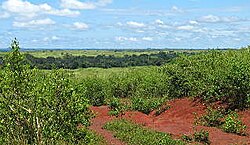메시에 26
Messier 26| 메시에 26 | |
|---|---|
 오픈 클러스터 메시 26 학점: 힐러리 마티스, 바네사 하비, REU 프로그램/NOIRLab/NSF/AURA | |
| 관측 데이터(J2000.0 epoch) | |
| 별자리 | 스쿠텀 |
| 우측 상승 | 18h 45m 18.0s[1] |
| 탈위임 | −09° 23′ 00″[1] |
| 거리 | 5,160 ly (1,582 pc)[2] |
| 겉보기 크기 (V) | 8.0[3] |
| 외관 치수(V) | 14′[3] |
| 물리적 특성 | |
| 반지름 | 11리[4] |
| 추정연령 | 8530만년[1] |
| 기타 지정 | 메시에 26, NGC 6694,[5] Cr 389, C 1842-094 |
메시에 26은 NGC 6694로도 알려져 있으며, 남쪽의 스쿠텀 별자리에 있는 열린 항성 군집이다. 그것은 1764년 찰스 메시에에 의해 발견되었다.[a] 이 8번째 크기 군집은 현대적인 최소 3인치(76 mm) 조리개 장치를 가진 전형적인 쌍안경으로 이상적인 하늘에서 찾기 위한 도전이다. 열린 성단 메시에 11의 남남서쪽에 있으며, 가로 14㎝이다.[3] 약 25개의 별들이 150~200mm(6~8인치)의 개구부를 가진 망원경으로 보인다.[6]
M26은 직경 22광년의[4] 선형 크기에, 조석 반경은 25광년이며,[7] 지구에서 5,160광년[2] 떨어져 있다. 가장 밝은 별은 진도 11이고[6] 이 성단의 나이는 8530만년으로[1] 계산되었다. 그것은 알려진 분광형 2진법을 포함한다.[8]
M26의 흥미로운 특징은 핵 근처에 있는 낮은 항성 밀도의 지역이다. 가설은 우리와 성단 사이의 성간 물질의 구름에 의해 발생한다는 것이었지만, 제임스 커페이의 논문은 이것이 불가능하며 정말로 "낮은 항성 공간 밀도의 껍데기"라는 것을 시사했다.[9] 2015년, 노팅엄 대학의 마이클 메리필드는 아직 이 현상에 대한 명확한 설명은 없다고 말했다.[10]
갤러리
각주 및 참조
각주
- ^ 6월 20일
참조
- ^ a b c d Wu, Zhen-Yu; et al. (November 2009), "The orbits of open clusters in the Galaxy", Monthly Notices of the Royal Astronomical Society, 399 (4): 2146–2164, arXiv:0909.3737, Bibcode:2009MNRAS.399.2146W, doi:10.1111/j.1365-2966.2009.15416.x.
- ^ a b Kharchenko, N. V.; et al. (2005), "Astrophysical parameters of Galactic open clusters", Astronomy and Astrophysics, 438 (3): 1163–1173, arXiv:astro-ph/0501674, Bibcode:2005A&A...438.1163K, doi:10.1051/0004-6361:20042523.
- ^ a b c Thompson, Robert; Thompson, Barbara (2007), Illustrated Guide to Astronomical Wonders: From Novice to Master Observer, DIY science, O'Reilly Media, Inc., p. 431, ISBN 978-0596526856
- ^ a b Kharchenko, N. V.; et al. (March 2009), "Shape parameters of Galactic open clusters", Astronomy and Astrophysics, 495 (3): 807–818, arXiv:0812.3542, Bibcode:2009A&A...495..807K, doi:10.1051/0004-6361/200810407.
- ^ "M 26". SIMBAD. Centre de données astronomiques de Strasbourg. Retrieved November 15, 2018.
- ^ a b Burnham, Robert (1978), Burnham's Celestial Handbook: An Observer's Guide to the Universe Beyond the Solar System, Dover books on astronomy, vol. 3, Courier Corporation, p. 1756, ISBN 978-0486236735
- ^ Piskunov, A. E.; et al. (January 2008), "Tidal radii and masses of open clusters", Astronomy and Astrophysics, 477 (1): 165–172, Bibcode:2008A&A...477..165P, doi:10.1051/0004-6361:20078525.
- ^ Mermilliod, J. -C.; et al. (October 2007), "Red giants in open clusters. XIII. Orbital elements of 156 spectroscopic binaries", Astronomy and Astrophysics, 473 (3): 829–845, Bibcode:2007A&A...473..829M, doi:10.1051/0004-6361:20078007.
- ^ Cuffey, James (1940). "The Galactic Clusters NGC 6649 and NGC 6694". Astrophysical Journal. 92: 303. Bibcode:1940ApJ....92..303C. doi:10.1086/144220.
- ^ Merrifield, Michael (Oct 2, 2015). "M26 - Open Cluster". Deep Sky Videos. University of Nottingham/University of Sheffield. Retrieved March 29, 2016.
외부 링크
| 위키미디어 커먼즈에는 메시에 26과 관련된 미디어가 있다. |




